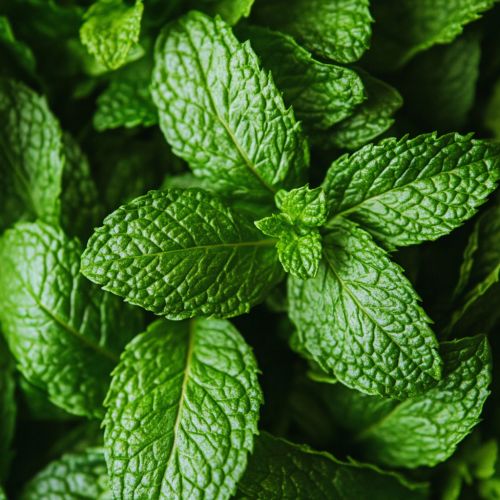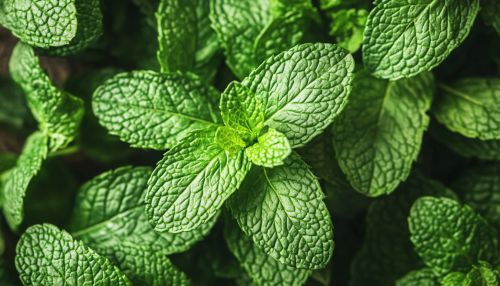Mentha: Difference between revisions
(Created page with "== Introduction == '''Mentha''', commonly known as mint, is a genus of plants in the family Lamiaceae. This genus comprises approximately 25 to 30 species, including the well-known peppermint (''Mentha × piperita'') and spearmint (''Mentha spicata''). These aromatic perennials are renowned for their fragrant leaves and are widely used in culinary, medicinal, and industrial applications. The genus is native to Europe, Africa, Asia, Australia, and North America, and...") |
No edit summary |
||
| Line 3: | Line 3: | ||
'''Mentha''', commonly known as mint, is a genus of plants in the family [[Lamiaceae]]. This genus comprises approximately 25 to 30 species, including the well-known peppermint (''Mentha × piperita'') and spearmint (''Mentha spicata''). These aromatic perennials are renowned for their fragrant leaves and are widely used in culinary, medicinal, and industrial applications. The genus is native to Europe, Africa, Asia, Australia, and North America, and it thrives in a variety of habitats, from wetlands to dry soils. | '''Mentha''', commonly known as mint, is a genus of plants in the family [[Lamiaceae]]. This genus comprises approximately 25 to 30 species, including the well-known peppermint (''Mentha × piperita'') and spearmint (''Mentha spicata''). These aromatic perennials are renowned for their fragrant leaves and are widely used in culinary, medicinal, and industrial applications. The genus is native to Europe, Africa, Asia, Australia, and North America, and it thrives in a variety of habitats, from wetlands to dry soils. | ||
[[Image:Detail-98401.jpg|thumb|center|alt:Close-up of fresh mint leaves with a vibrant green color.|class=only_on_mobile]] | |||
[[Image:Detail-98402.jpg|thumb|center|alt:Close-up of fresh mint leaves with a vibrant green color.|class=only_on_desktop]] | |||
== Taxonomy and Classification == | == Taxonomy and Classification == | ||
Latest revision as of 08:34, 11 October 2024
Introduction
Mentha, commonly known as mint, is a genus of plants in the family Lamiaceae. This genus comprises approximately 25 to 30 species, including the well-known peppermint (Mentha × piperita) and spearmint (Mentha spicata). These aromatic perennials are renowned for their fragrant leaves and are widely used in culinary, medicinal, and industrial applications. The genus is native to Europe, Africa, Asia, Australia, and North America, and it thrives in a variety of habitats, from wetlands to dry soils.


Taxonomy and Classification
The taxonomy of Mentha is complex due to the extensive hybridization and polyploidy within the genus. The genus belongs to the order Lamiales, which includes other aromatic herbs such as basil and rosemary. The species within Mentha are characterized by their square stems, opposite leaves, and small flowers, which are typically white, pink, or purple.
Species and Hybrids
Several species and hybrids are recognized within the genus Mentha. Some of the most notable include:
- Mentha spicata (Spearmint): Known for its sweet flavor, spearmint is commonly used in culinary applications and as a flavoring agent in toothpaste and chewing gum.
- Mentha × piperita (Peppermint): A hybrid of watermint (Mentha aquatica) and spearmint, peppermint is widely used in herbal teas and essential oils.
- Mentha arvensis (Field Mint): Often used in traditional medicine, field mint is native to Europe and Asia.
- Mentha longifolia (Horse Mint): Known for its strong aroma, horse mint is used in both culinary and medicinal contexts.
Phylogenetic Relationships
Phylogenetic studies have revealed that Mentha is closely related to other genera within the Lamiaceae family, such as Salvia and Thymus. Molecular analyses using DNA sequencing have helped clarify the evolutionary relationships among Mentha species, although the high degree of hybridization continues to pose challenges for taxonomists.
Morphology
The morphology of Mentha plants is characterized by several distinct features that contribute to their identification and classification.
Vegetative Characteristics
Mentha species typically exhibit square stems, a characteristic feature of the Lamiaceae family. The leaves are simple, opposite, and decussate, with a serrated margin. The leaves contain glandular trichomes that secrete essential oils, responsible for the plant's characteristic aroma.
Reproductive Structures
The inflorescences of Mentha are terminal or axillary spikes, with small, bilabiate flowers. The calyx is tubular, and the corolla is two-lipped, with four stamens. The fruit is a schizocarp, splitting into four nutlets upon maturity.
Ecology and Distribution
Mentha species are found in a wide range of ecological habitats, from temperate to tropical regions. They are often found in moist environments, such as riverbanks, wetlands, and meadows.
Habitat Preferences
Most Mentha species prefer well-drained, moist soils with a neutral to slightly acidic pH. They thrive in full sun to partial shade and are often found in disturbed habitats, where they can quickly colonize open areas.
Geographical Distribution
The genus Mentha is distributed across Europe, Asia, Africa, Australia, and North America. Some species, such as peppermint and spearmint, have been widely cultivated and naturalized in regions outside their native range.
Uses and Applications
Mentha species have been utilized for their aromatic and medicinal properties for centuries. Their uses span culinary, medicinal, and industrial applications.
Culinary Uses
Mint leaves are a popular ingredient in various cuisines worldwide. They are used fresh or dried to flavor dishes, beverages, and desserts. Spearmint is commonly used in Middle Eastern and Mediterranean cuisines, while peppermint is a key ingredient in confectionery and herbal teas.
Medicinal Uses
The medicinal properties of Mentha have been recognized since ancient times. Peppermint oil, extracted from the leaves, is used to treat digestive disorders, headaches, and respiratory ailments. The menthol in peppermint oil has analgesic and anti-inflammatory properties.
Industrial Applications
Mint essential oils are used in the production of cosmetics, perfumes, and personal care products. The oils are also employed as natural insect repellents and in aromatherapy.
Cultivation and Propagation
Mentha species are relatively easy to cultivate and propagate, making them popular in home gardens and commercial agriculture.
Growing Conditions
Mint plants prefer a sunny location with well-drained, fertile soil. They require regular watering, especially during dry periods, to maintain healthy growth. Due to their vigorous growth habit, mint plants can become invasive if not managed properly.
Propagation Techniques
Mint is commonly propagated through vegetative methods, such as stem cuttings and division. Stem cuttings can be rooted in water or soil, while division involves separating the root clumps and replanting them.
Challenges and Considerations
While Mentha species are valued for their versatility, they also present certain challenges in cultivation and management.
Invasive Potential
Many Mentha species are aggressive growers and can become invasive in certain environments. Gardeners and land managers must take precautions to prevent the spread of mint plants beyond intended areas.
Pests and Diseases
Mint plants are susceptible to various pests and diseases, including aphids, spider mites, and rust. Regular monitoring and integrated pest management strategies can help mitigate these issues.
